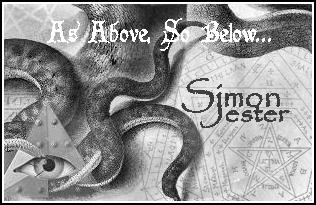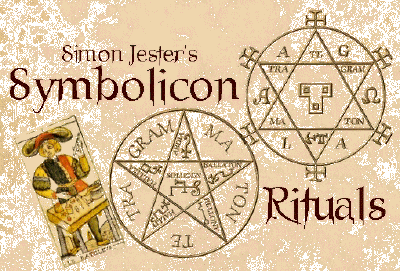Learning the Lesser Hexagram Rituals
Part IIby Simon Jester
The Analysis of the Key Word
In Part I of this lesson, I explained how to form the four Elemental Hexagrams used in the Lesser Hexagram Rituals. Now we must examine a much more complex element of these rituals, one that calls upon the sanctifying power of Sol (assigned to Tiphereth on the Tree of Life) to infuse the magician with the Higher Forces required to wield the power of the Hexagram.
In the Golden Dawn tradition, the actual drawing of the four different Elemental Hexagrams in the Lesser Hexagram Rituals is preceded and followed by a very important ritual called The Analysis of the Key Word. The Word in question is actually the familiar acronym formed from the Roman letters "I N R I" that were written on a placard and placed as a sign over the body of Christ on the cross. These letters were an abbreviation of the phrase: "Iesvs Nazarenvus Rex Iudaeorvm" which translates as "Jesus of Nazareth, King of the Jews." An alternate alchemical tradition expands these letters into the Latin phrase: "Igne Natura Renovatur Integra," which translates into English as "By Fire is Nature Renewed to Perfection." Regardless of which phrase the acronym is believed to denote, when the letters I, N, R & I are transliterated into their approximate Hebrew equivalents, the letters yod, nun, reish & yod are derived, and this particular arrangement of letters is laden with deep Qabalistic significance. They describe a whole recurring cosmic cycle of birth, death, and rebirth.
In the Qabalah, the letter yod designates the creative Fire of Chokmah. Nun (in the Golden Dawn tradition) is assigned to the Death card of the Tarot deck. Reish (again in the Golden Dawn tradition) is associated with the Sun and rebirth. The Hebrew letters arranged in this fashion thus encapsulate the story of the Spirit's descent into materiality (Death) and its return to God through an inner awakening to the reality of its divine identity.
MacGregor Mathers, the probable creator of The Analysis of the Key Word, was a child of his times, and his use of Egyptian elements in the ritual provides an example of the late Victorian fascination with all things Egyptian. Elements from the Osiris myth (which also expresses a birth—death—rebirth cycle) were included to form a syncretistic Judeo-Christian/Egyptian hybrid. After intoning the Hebrew letters yod, nun, reish & yod, the ceremonialist assumes the Sign of the Cross by extending his or her arms and says: "The Sign of Osiris slain." Next follows a series of three more statements, each accompanied by their own Sign, which have great significance in the Golden Dawn tradition. The ceremonialist says, "The Sign of the Mourning of Isis" and assumes the appropriate sign (in which the right arm is held upright while the left is held out at a right angle to the body to create an "L" shape.) Next, the phrase "The Sign of Typhon and Apophis" is intoned while making a "V" sign with the arms above the head. Then the arms are crossed into an "X" position over the chest and the words "The Sign of Osiris Risen" are spoken.
How these particular letters are associated with the Egyptian deities being named is a matter of conjecture, and different explanations exist. Certainly, Mathers employed no legitimate historical/philological method when he created the ritual. His concern was not to propose a literal linguistic connection between Latin, Hebrew, and ancient Egyptian. Rather, he wished to provide a ritualistic/artistic expression of an archetypal motif, and therefore fashioned a poetic blending of different mythological elements, choreographed together with movements and gestures, that he hoped would convey a sense of the universal meaning and unity underlying diverse cultural forms. Basically, The Analysis of the Key Word is a minimalist dance performance thematically based on the Perennial Philosophy. The letter "L" is probably associated with the goddess Isis because the distinctive headgear she wears in most ancient Egyptian artistic representations resembles this letter. "V" is associated with Apophis, the serpent enemy of the sun god, because its shape resembles the head of a snake. And mummiform representations of the reanimated Osiris depict this god with his arms crossed over his chest in an "X" position identical to the one used in the ritual.
The magician gives the "L" "V" "X" signs a second time and pronounces these letters aloud (by saying "ell," "vee," & "ex") as they are formed with the arms. Then, he or she intones the Latin word for Light: "Lux" and immediately spreads his or her arms outward, once more assuming the Sign of the Cross/Osiris Slain while saying: "The Light of the Cross." At this point, the ritual has actually turned back upon itself like a circle, and, through returning to the symbol of the Cross from where it began, becomes an embodiment of the great cosmic cycle that it strives to invoke.
While assuming the Sign of the Cross for this second time, three more magical phrases are intoned that further connect Isis, Apophis, and Osiris to Virgo, Scorpio, and Sol. The Golden Dawn associates these two Zodiac signs with the Paths of yod and nun on the Tree of Life, and the sun is associated with the Path of reish, so the three significant Hebrew letters from which the whole performance begins receive further amplification in this part of the ritual.
Next, the deities Isis, Apophis, and Osiris are renamed as the magician slowly raises hands high above his or her head. He or she then spreads the hands wide while looking straight up, as though at an intensely bright light, and vibrates the Gnostic word for God: "IAO"—which also happens to be formed from the first letters of the three Egyptian god's names when they are translated into English. Again, it's unlikely that Mathers viewed this as proof of a philological connection between the ancient Egyptian language and Greek, Latin or English, and saw it as simply a meaningful coincidence that could help amplify the archetypal theme of the ritual.
After the vibration of "IAO," Mathers centers the energies that are now poised to manifest via a brief invocation to the Four Quarters. This is done to give the magician a secure center of balance from where he or she may be able to handle and control the great energies being summoned. To distinguish what is being done here from the purely Elemental intentions of the Pentagram rituals, Mathers uses the Enochian Angelic Names Exarp, Hcoma, Nanta, and Bitom in this invocation to the four cardinal directions. I have seen these Names explained in several places as being simply the Enochian equivalents of the Names for the Archangels Raphael, Gabriel, Michael, and Uriel that are used in the Lesser and Greater Rituals of the Pentagram. This is incorrect.
The full explanation of the meaning and significance of these Enocian terms goes beyond the scope of this blog entry, but the strange Names Exarp, Hcoma, Nanta, and Bitom derive from John Dee's Tablet of Union and are actually acronyms (or notariqons, to use the proper Qabalistic term) formed from the first letters of the Names of Angelic Princes, who form four ranks of five Princes each. (In other words, each letter of each Name is itself the first letter of the Name of an Angelic Prince.) Each of these Ranks of Princes is associated with one of the Enochian Watchtowers of the Four Quarters.
After calling out the notariqons used to designate the four ranks of Angels, the magician concludes The Analysis of the Key Word by intoning the all-important final phrase: "Let the Divine Light descend!" while visualizing a beam of brilliant light coming down from on high and filling his or her body, mind, and spirit with intense brightness. This is the climax of the ritual, the Summum Bonum, for which the whole Analysis of the Key Word ritual is designed. It is like the lifting of the rods in a magical nuclear reactor that initiates an archetypal atomic reaction capable of yielding vast oceans of energy. The words, phrases, signs and gestures preceding this moment should all be visualized as magical devices used to stir mighty currents of energy into an astral cyclone that forms and spins with ever growing force around the magician at the center; currents of immense energy that finally focus and hurtle down into the magician like a thunderbolt with the dramatic intonation of the final phrase of the ritual.
When its component elements are examined, The Analysis of the Key Word seems very complex and difficult to perform. Many people initially experience a negative reaction to it, and I have seen this ritual described in one place as a kind of weird Hermetic version of "Y.M.C.A."--the Village People's hit single! But if you take it one step at a time, and try to learn it in manageably small segments, you will be able to master it. You will begin to find that it is an exceedingly powerful ritual and that its use will greatly enhance your Pathworkings.
Here is the Lesser Hexagram Ritual in its entirety, with instructions for the drawing of the Elemental Hexagrams included:
The Lesser Ritual of the Hexagram
1. Face East. Perform the Qabalistic Cross.
2. Assume the form of the Cross (the + sign.) Say: "INRI—yod-nun-reish-yod. The Sign of Osiris slain."
3. Assume the Sign of the Mourning of Isis (the L sign.) Say: "The Sign of the Mourning of Isis."
4. Assume the Sign of Apophis (the V sign.) Say: "The Sign of Typhon and Apophis."
5. Assume the Sign of Osiris Risen (the X sign.) Say: "The Sign of Osiris Risen."
6. Repeat these Signs, saying: "L—V—X. Lux! The Light of the Cross."
7. Assume the Form of the Cross again. Say: "Virgo! Isis! Mighty Mother! Typhon! Apophis! Destroyer! Sol! Osiris! Slain and Risen!"
8. Hold arms above head, then spread your hands wide apart with a quick motion and raise your head to look high above. Say: "IAO! Exarp! Hcoma! Nanta! Bitom! Let the Divine Light Descend!"
9. Perform the Qabalistic Cross to further balance the energy.
10. Now, while facing East, draw the Fire Hexagram. Start with the point associated with the planetary forces you are going to either banish or invoke and follow the instructions given in my previous entry concerning how to form the two triangles of the Elemental Hexagrams.
11. Turn to the South while forming a connecting line of white light from center the Fire Hexagram. Now draw the Earth Hexagram as explained in Part I.
12. Turn to the West while forming a connecting line of white light from the center of the Earth Hexagram. Draw the Air Hexagram as explained in Part I.
13. Turn to the North while forming a connecting line of white light from the center of the Air Hexagram. Draw the Water Hexagram as explained in Part I.
14. Turn back to the East while forming a connecting line of white light from the center of the Water Hexagram, thus completing the magic circle around yourself.
15. Now perform the ritual of The Analysis of the Key Word again, and conclude with the Qabalistic Cross.
If you have any questions concerning this highly important ritual, please feel free to ask. In a another essay (found in the "Demons" section--see navigation bar at right) I explain how you can use it to banish the specific Qlipothic forces associated with the Qabalistic Paths and safeguard your Pathworkings from demonic contamination.

